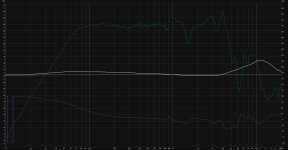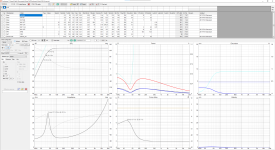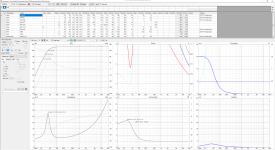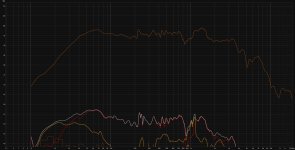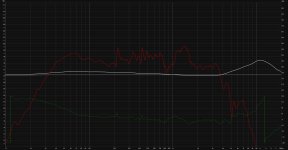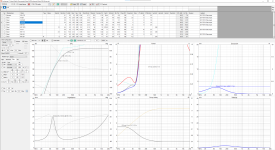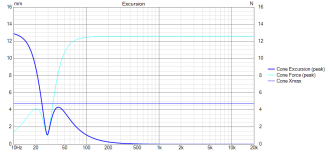Hi all, a while ago I purchased a very lightly used set of, all Morel, ET 338, CAW 538 and CAW 938. My intention was and still hopefully is to pack these drivers into a nice 3 way speaker.
I have been learning VituixCAD but am a bit stumped with designing an enclosure for the CAW 938. I have a few questions about this regarding simulated SPL, Xmax and overall rules around these topics.
Please correct me if I'm wrong with anything above. Please see some enclosure simulations below and also some nearfield measurements of the CAW 938 and 538 test enclosures, these measurements are also gated from memory.
Hopefully this data is enough to go on, let me know if not or you need any more info. All measurements in REW have 1/24th smoothing applied.
EDIT: Sorry I also forgot to add the nearfeild accuracy cut off's.
Thank you!
I have been learning VituixCAD but am a bit stumped with designing an enclosure for the CAW 938. I have a few questions about this regarding simulated SPL, Xmax and overall rules around these topics.
- What SPL should these speakers be able to play up to, as in max db SPL for loud listening in a medium to large lounge at between 3-5m listening distance? Or if there is a standard for general high end home audio speaker I would be happy to aim for that.
- In terms of woofer roll off at what point do you not need to worry about cone excursion, weather that's referencing the SPL roll off, the power dip at the impedance spike, cone force or velocity. I have looked around but cannot find any solid information on what is safe in terms of Xmax, everything from sealed enclosure to bass reflex and band pass all pass the rated Xmax of driver even at fairly low wattage, why is this not a big concern. What are some good rules or parameters to follow in terms of this while getting the desired SPL output.
- I really want to do a nice job with these speaker as it will be the first I have designed myself and will be my daily drivers. Keeping this in mind they will be mainly used for music and watching movies. I would ideally like the qtc to be reasonably balance around 0.707 to avoid sloppiness or compression.
- I have built and done some measurement on some test enclosures. The volumes and dimensions are listed below:
- CAW 938: 320mm x 730mm x 436mm, built in 18mm OBS, the volume is 76.5L with a qtc around 0.71.
- CAW 538: 260mm x 320mm x 210mm built with the same 18mm OBS, the volume is 10.5L giving a qtc of 0.5 to hopefully keep the mids nice and dynamic.
- Finally, is the CAW 938 not suited for a low range woofer, my initial goal was anywhere from 500 to 250Hz down to the driver roll off with no HPF. If this does not seem viable I could definitely use it for a 2 way using it with a beyma compression driver.
Please correct me if I'm wrong with anything above. Please see some enclosure simulations below and also some nearfield measurements of the CAW 938 and 538 test enclosures, these measurements are also gated from memory.
Hopefully this data is enough to go on, let me know if not or you need any more info. All measurements in REW have 1/24th smoothing applied.
EDIT: Sorry I also forgot to add the nearfeild accuracy cut off's.
- CAW 938: 655Hz
- CAW 538: 1023Hz
Thank you!
Attachments
Last edited:
What SPL should these speakers be able to play up to, as in max db SPL for loud listening in a medium to large lounge at between 3-5m listening distance? Or if there is a standard for general high end home audio speaker I would be happy to aim for that.
Hello
It's more like can they meet your SPL requirements in your room at a given distance. For example what are your Peak SPL requirements at the given listening distance? You can use the calculator to help work it out. Just drop in sensitivity, distance, placement and power available to get the max SPL. The other question is for example do you plan on using them to watch movies at THX levels? In that case SPL requirements are clearly defined. So you plug it in and see if you can meet them.
This should help on this:
WRT X-Max just design not to exceed it for your chosen peak SPL. You can for brief periods as there is an X-Mec which you avoid exceeding at all cost. Just use common sense. You should have displacement vs frequency and power in your sims as a reference. The obvious is you need to know again what the target peak SPL requirement is.
Rob 🙂
https://mehlau.net/audio/spl/
Last edited:
There's no obvious answer to this question. It comes down to how you intend to use the driver. If you model with excessive power levels at low frequencies, you're definitely going to exceed Xmax in lots of conditions. A 9 inch woofer is only going to do so much. At low frequencies, it's mostly about volume displacement in the end. Each octave you go down requires 4x the volume displacement to maintain the same SPL level. So at Xmax that driver might be able to run you out of the room at 200 Hz, but it's going to be much more polite at 20 Hz.In terms of woofer roll off at what point do you not need to worry about cone excursion
For normal home audio, there's typically a handoff in the midbass or bass region where you switch from excursion limiting output to thermal considerations limiting output. So at higher frequencies the wattage limit of the voicecoil comes into play more directly, but at lower frequencies it's more to do with the enclosure and excursion.
To me, that woofer looks best for what you originally described: a 3-way. The impedance and frequency response discontinuities starting at 800 Hz would give me some concern from a general design standpoint. Maybe you can stretch the usable range to 1500 Hz, but it's something I'd listen to and measure before committing to. It comes down to what you find important from a design standpoint.CAW 938 not suited for a low range woofer, my initial goal was anywhere from 500 to 250Hz down to the driver roll off with no HPF. If this does not seem viable I could definitely use it for a 2 way using it with a beyma compression driver.
https://www.parts-express.com/pedocs/specs/297-086--morel-caw-938-spec-sheet.pdf
A 9-inch woofer also isn't that large in the grand scheme of things, so it's unlikely to be "loud" at 20 Hz. My idea of loud and your idea of loud may be two completely different things though. Do you have experience with any speakers you think were loud enough for your listening style? That might help set a reasonable target for what SPL you want. Erin's Audio Corner has quite a few speaker tests up that include distortion (86 and 96 dB at 1 meter) and dynamic range testing (76, 86, 96, 102 dB at 1 meter).
Last edited:
My main concern is around the woofer being safe from mechanical damage from over excursion and also have low compression as to keep dynamic. I will be using them for both music and home theatre as I said previously. Which leads me to the concern of not being able to play them loud enough before distortion starts to affect the low from mechanical limits. I don't mind if it only plays to 60Hz as I will definitely be building some subs in the future to good bass extension.A 9-inch woofer also isn't that large in the grand scheme of things, so it's unlikely to be "loud" at 20 Hz. My idea of loud and your idea of loud may be two completely different things though. Do you have experience with any speakers you think were loud enough for your listening style? That might help set a reasonable target for what SPL you want. Erin's Audio Corner has quite a few speaker tests up that include distortion (86 and 96 dB at 1 meter) and dynamic range testing (76, 86, 96, 102 dB at 1 meter).
Yes, that is exactly what I'm going for but don't have a calibrated SPL meter so can't tell what is "loud enough" for myself. So I do think following what reference levels for movies, such as Dolby and THX, including the headroom, is a good baseline as this is likely the loudest it would be comfortable to play would be.WRT X-Max just design not to exceed it for your chosen peak SPL. You can for brief periods as there is an X-Mec which you avoid exceeding at all cost. Just use common sense. You should have displacement vs frequency and power in your sims as a reference. The obvious is you need to know again what the target peak SPL requirement is.
From what it looks like is an average level of 85dB at the listening position with 20dB headroom, taking it to 105dB. Below is a chart of SPL loss due to distance to the listening position.
| Listening Distance | SPL Loss | Required Speaker Output at 1m |
|---|---|---|
| 2m | -6 dB | 91 dB |
| 3m | -9.5 dB | 94.5 dB |
| 4m | -12 dB | 97 dB |
| 5m | -14 dB | 99 dB |
| 6m | -15.5 dB | 100.5 dB |
| 7m | -17 dB | 102 dB |
| 8m | -18 dB | 103 dB |
| 9m | -19 dB | 104 dB |
| 10m | -20 dB | 105 dB |
So I'm wondering if this is the main this I should be simulating to. Or am I needing to simulate everything to the peak/headroom of 105dB at the listening position? Here is the chart for 105dB at listening position.
| Distance (m) | SPL Loss (dB) | Required Speaker SPL @ 1m (dB) |
|---|---|---|
| 2m | -6.02 | 111.0 |
| 3m | -9.54 | 114.5 |
| 4m | -12.04 | 117.0 |
| 5m | -13.98 | 118.98 |
| 6m | -15.56 | 120.56 |
| 7m | -16.90 | 121.9 |
| 8m | -18.06 | 123.1 |
| 9m | -19.08 | 124.1 |
| 10m | -20.00 | 125.0 |
This however looks unrealistic to achieve even at 2m for even the caw 938 which does not hit Xmax at its RMS of 150W, with a 1st order HPF at 250Hz, and only achieves about 107dB. In the headroom aspect does it only need to be under peak power ratings and X_mech?
Cheers!
Attachments
Most of the time, model for the worst case output level, not the power input rating. Since you are targeting home theater, shoot for 105dB, and adjust the wattage input to reflect that. Then fiddle with the enclosure and see where it models safely at those benchmarks. I do not feel you'll need 3 cubic feet, likely more like 1.5 cubes to make it happy. You could buy another pair of woofers and likely use both per cabinet in that 3 cubes. This will also help meet your output requirements as I'm uncertain you can meet them without a total quad of woofers.
938 seems to have a Qts of .52
So the box would be on the larger size.
Whatever volume it takes to get .7 Qtc
Not a very strong magnet, so it wants a big box
The Fs of the speaker seems pretty decent around 29 Hz
Assuming without doing sim, QB4 is what it wants, which will tune slightly below 29 Hz 3 or 4 Hz
That is about it. Speaker is what it is. Not much to overthink
All vented enclosures will start to unload below the port tuning.
Xmax is 10% distortion, so most would listen around 3 to 6% distortion.
With movies there is big transients for sound effects. Is what it is.
Assume you listen around 86 to 88 dB and 92 to 96 dB if you like loud.
Or if the movie sound jumps all over the place from low dialog to loud sound effects.
So around 5 to 8 volts RMS with 10 to 16 volts for loud parts in the movies.
So as with most 85 dB speakers your listening at 3 to 4% distortion in low frequency and with big transients
It shoots close to 7% to 10%. Why there is plenty of towers out there with 2x woofers to tame that down.
Assuming the front plate is typical 6mm to 7mm the magnet is only strong enough to use 4.2 mm of that
before it reaches 10% distortion. Or 70% of available magnet Bl
Something with a stronger magnet will get lower into .3 Qts showing more magnet control.
So the box would be on the larger size.
Whatever volume it takes to get .7 Qtc
Not a very strong magnet, so it wants a big box
The Fs of the speaker seems pretty decent around 29 Hz
Assuming without doing sim, QB4 is what it wants, which will tune slightly below 29 Hz 3 or 4 Hz
That is about it. Speaker is what it is. Not much to overthink
All vented enclosures will start to unload below the port tuning.
Xmax is 10% distortion, so most would listen around 3 to 6% distortion.
With movies there is big transients for sound effects. Is what it is.
Assume you listen around 86 to 88 dB and 92 to 96 dB if you like loud.
Or if the movie sound jumps all over the place from low dialog to loud sound effects.
So around 5 to 8 volts RMS with 10 to 16 volts for loud parts in the movies.
So as with most 85 dB speakers your listening at 3 to 4% distortion in low frequency and with big transients
It shoots close to 7% to 10%. Why there is plenty of towers out there with 2x woofers to tame that down.
Assuming the front plate is typical 6mm to 7mm the magnet is only strong enough to use 4.2 mm of that
before it reaches 10% distortion. Or 70% of available magnet Bl
Something with a stronger magnet will get lower into .3 Qts showing more magnet control.
In terms of excursion required, it depends hugely on the content you like to play and the levels you want to play it at. Most music has little energy below 40Hz, and high level signals in the bottom octave are extremely rare. But home theatre is a different game altogether, with high level low bass (and subsonic) content very common.
Hence inefficient compact ported speakers, with woofers which will exceed xmax at 20 Hz with just a couple of watts, often play loud and survive perfectly well for years when used for music only. Feed them HT content at the same levels, though, and you'll destroy them quickly.
So the question is whether your woofers, in a box big enough to give your desired Q, will cope with HT content at your preferred levels without an HPF. The answer really depends on your preferred levels. Vituixcad should tell you what level can you get out of them (across the passband) when they are reaching linear xmax at 20 Hz.
Hence inefficient compact ported speakers, with woofers which will exceed xmax at 20 Hz with just a couple of watts, often play loud and survive perfectly well for years when used for music only. Feed them HT content at the same levels, though, and you'll destroy them quickly.
So the question is whether your woofers, in a box big enough to give your desired Q, will cope with HT content at your preferred levels without an HPF. The answer really depends on your preferred levels. Vituixcad should tell you what level can you get out of them (across the passband) when they are reaching linear xmax at 20 Hz.
Hmm. Just tried a quick model of the CAW938 in Basta. In a 60 to 70 litre box, hitting xmax at 40 Hz and below with 8 V, passband SPL in the low 90s. Not great (for HT).
(Edit: they model quite nicely in a much smaller box - even 10 litres - with a series 500 uF cap. The -6dB is about 60 Hz, and 10dB more is possible before they run out of excursion.)
(Edit: they model quite nicely in a much smaller box - even 10 litres - with a series 500 uF cap. The -6dB is about 60 Hz, and 10dB more is possible before they run out of excursion.)
Last edited:
10 liters for a .5 Qts speaker.
I dont think so, be rather boomy and slow. It is a weak magnet.
For midbass on a high pass Qtc be acceaptable no higher than .8 Qtc
Extremely generic speaker, why they bothered with a cast frame beats me.
Same old same old.
Probably wants 2.5 cubic feet roughly 75 liters to be .7 Qtc
Smallest tolerable probably be 1.5 cubic feet or 45 liters.
likely have the typical high Qts peak.
Tradeoff between the 2 likely be whatever the heck a BB4 alignment is.
Whatever volume it needs for .8 Qtc, then tune at Fs. All you get
Magnet has a hard time doing its job, the volume will be large regardless.
Excursion will be what it will be. Making boxes too small doesnt fix much.
CB4 or BB4 push auto calculate, your done. No magic science
I dont think so, be rather boomy and slow. It is a weak magnet.
For midbass on a high pass Qtc be acceaptable no higher than .8 Qtc
Extremely generic speaker, why they bothered with a cast frame beats me.
Same old same old.
Probably wants 2.5 cubic feet roughly 75 liters to be .7 Qtc
Smallest tolerable probably be 1.5 cubic feet or 45 liters.
likely have the typical high Qts peak.
Tradeoff between the 2 likely be whatever the heck a BB4 alignment is.
Whatever volume it needs for .8 Qtc, then tune at Fs. All you get
Magnet has a hard time doing its job, the volume will be large regardless.
Excursion will be what it will be. Making boxes too small doesnt fix much.
CB4 or BB4 push auto calculate, your done. No magic science
Yes. Without the high-pass cap, certainly. Q would be 1.2.10 liters for a .5 Qts speaker.
I dont think so, be rather boomy and slow. It is a weak magnet.
With the cap, I don't know. The model looks promising. (I've not tried a setup like that, though.)
Well, that's problem the OP asked about. Efficiency is modest, and in a large sealed box you're going to go over xmax quite easily with HT.Excursion will be what it will be.
I've messed around with the simulations a bunch and looking at trying to model for 105dB at listening position of a couple meters meaning I'd be aiming for about 115dB SPL which does seem very high and only achievable if I use 12 drivers per cabinet. This makes me wonder if the reference level, for THX and what not, is more talking about the peak power levels of the driver being able to handle this. I am still unsure however on what this would be in terms of the mechanical side of things, I'm guessing it would be ensuring it doesn't pass its X_mech?Since you are targeting home theater, shoot for 105dB, and adjust the wattage input to reflect that.
I have done simulations with pretty much every enclosure type available on vituixCAD, mainly to satisfy my own curiosity on how drivers react to different enclosure types. The thing that I'm still stumped on is how the cone excursion pretty much always passes Xmax when given normally pretty minimal wattage, say 10W which for the 938 only takes it to about 95dB SPL, on any type of mid woofer and its only when you go to specially to a high excursion woofer such a sub you are able to input more power and in turn get louder volumes.The Fs of the speaker seems pretty decent around 29 Hz
Assuming without doing sim, QB4 is what it wants, which will tune slightly below 29 Hz 3 or 4 Hz
That is about it. Speaker is what it is. Not much to overthink
All vented enclosures will start to unload below the port tuning.
What I'm getting to here is I don't understand how speaker companies build speakers with small woofers with, say about, 5mm to Xmax, not implement a high pass filter and the driver doesn't rip itself apart. Especially when it's a ported enclosure where the cone excursion skyrockets when it becomes unloaded. I'm assuming speaker companies know what they're doing and not just hoping you don't play some bass heavy audio to loud.
I understand that the driver roll off means there is less cone force being applied at the high excursions in a seal enclosure and when a ported enclosure is unloaded but there is still the risk of mechanical damage if X_mech is reach even with low cone force. Do speaker designers just accept excursion past Xmax if it's under a specific con force or something?
I have attached a cone excursion and force graph below to give a visual representation of what I'm talking about; the simulation is the 938 in a SBB4 ported enclosure, fed with 10W achieving an average of about 96dB SPL.
Also, thanks so much for all the replies already, really appreciate it!
Attachments
Last edited:
Far as Xmech or mechanical damage, the rubber surround and cone for 938 look rather heavy so forward movement not as much as a big deal.
Most damage will occur with rearward movement, the voice coil will physically hit the rear magnet assembly.
woofers go well past Xmax it is nice when manufactures list mechanical limits
usually for extreme situations they " bump" back the rear magnet so it wont hit it as quickly.
forward movement is more suspension surround/spider.
Short story, sim assumes sinewave peak to peak, real music doesn't constantly run peak to peak.
With normal music and average to high listening levels
I would expect max spl to be around 96 to 98 dB.
Not smack the magnet, just high distortion
With movie soundtracks they love using deep slow rolling cheesy sound effects with lots of bass.
That is when at loud levels I have heard speakers click clack the back of the magnet.
Making the box smaller will decrease cone movement, but makes the speaker harder to move
and will increase Q. As mentioned .8 to high .88 Qtc is what I usually tolerate for cone control.
As you noticed the port unloads below tuning, no more air mass. It is what it is at that point.
A hole in a box. So lower the tuning the less likely it unloads.
People think 20 Hz is common for music when 30 Hz is more the limit.
So if you can get tuning below 30 Hz most the unloading can be ignored to a realistic power level.
People dont like the graph or transfer function of -3 dB bass shelf.
But it is one way to control unloading to tune 10 Hz below Fs.
Unloading is more a issue with smaller 45 Hz to 65 Hz Fs speakers.
Because normal music with EQ will yes unload them quick.
A woofer tuned 30 Hz or lower will take more power.
Compared to sealed response with better cone control, and compare a -3 dB bass shelf vented.
Usually you still get " more bass" and most people add 3 to 6 dB of EQ anyways.
Of course for cone control as mentioned used sealed as midbass.
The sub handles extreme bass at 40 to 30 Hz not imaginary 20 Hz.
Excursion protection is 4th order high pass filter usually around 7 to 10 Hz below the port.
unloading will usually vanish enough to never care at normal listening
Otherwise Sim with 2x woofers and you should get 100 to 103 dB.
Dont matter most dont listen above 89 to 93 dB. It is more " HiFi"
less distortion in the bass for same levels, not" max" levels
Most damage will occur with rearward movement, the voice coil will physically hit the rear magnet assembly.
woofers go well past Xmax it is nice when manufactures list mechanical limits
usually for extreme situations they " bump" back the rear magnet so it wont hit it as quickly.
forward movement is more suspension surround/spider.
Short story, sim assumes sinewave peak to peak, real music doesn't constantly run peak to peak.
With normal music and average to high listening levels
I would expect max spl to be around 96 to 98 dB.
Not smack the magnet, just high distortion
With movie soundtracks they love using deep slow rolling cheesy sound effects with lots of bass.
That is when at loud levels I have heard speakers click clack the back of the magnet.
Making the box smaller will decrease cone movement, but makes the speaker harder to move
and will increase Q. As mentioned .8 to high .88 Qtc is what I usually tolerate for cone control.
As you noticed the port unloads below tuning, no more air mass. It is what it is at that point.
A hole in a box. So lower the tuning the less likely it unloads.
People think 20 Hz is common for music when 30 Hz is more the limit.
So if you can get tuning below 30 Hz most the unloading can be ignored to a realistic power level.
People dont like the graph or transfer function of -3 dB bass shelf.
But it is one way to control unloading to tune 10 Hz below Fs.
Unloading is more a issue with smaller 45 Hz to 65 Hz Fs speakers.
Because normal music with EQ will yes unload them quick.
A woofer tuned 30 Hz or lower will take more power.
Compared to sealed response with better cone control, and compare a -3 dB bass shelf vented.
Usually you still get " more bass" and most people add 3 to 6 dB of EQ anyways.
Of course for cone control as mentioned used sealed as midbass.
The sub handles extreme bass at 40 to 30 Hz not imaginary 20 Hz.
Excursion protection is 4th order high pass filter usually around 7 to 10 Hz below the port.
unloading will usually vanish enough to never care at normal listening
Otherwise Sim with 2x woofers and you should get 100 to 103 dB.
Dont matter most dont listen above 89 to 93 dB. It is more " HiFi"
less distortion in the bass for same levels, not" max" levels
I will say if there's no way around it I will make an inline HPF and use it at the amp input, so components don't need to be crazy values. That is kind of the last resort because I would like to have speakers which are just safe to use in terms of the not damaging themselves.
A bit more about the build -
Main goals:
Ideas:
Let me know your thoughts on all of this and if I'm heading in the right direction or not.
Cheers!
A bit more about the build -
Main goals:
- High resolution and flat (ideally) response.
- Good imaging.
- Low distortion.
- Suitable for both Music and HT (for L and R channels, not needed to act as a sub).
Ideas:
- I'm intending to build the speakers with a passive crossover hopefully using some nice parts such a Jantzen and Miflex for example. I am thinking it would be nice to have these external.
- The CAW 538 test enclosure I built has a Qtc of 0.5, my thinking with this was hopefully to keep the mids very dynamic and natural sounds. I'm not set in this decision so let me know your thoughts on this.
- All the enclosures are just standard boxes for the test ones which I have made the dimensions as to evenly disperse modes within the enclosure. I am wondering if I maybe should go for a trapezoid or something along those lines to reduce internal reflections.
- Another idea I've been thinking about is to cover the speaker in felt to reduce diffraction, this would likely only need to be the front baffle but covering the entire speaker, at least the tweeter and mid woofer enclosure, could look rather nice if done right. I am hoping this would help the speakers "disappear" and help with the off-axis response.
- The previous owner of these has cut out some the faceplate of the tweeter, with the cutout following the curvature of the of the mid woofer. I don't this is a bad idea as it should improve the off-axis response having the acoustic centres closer together. I am concerned about getting phase issues if the happen to be the wrong distance apart.
- I was considering a tilted back front baffle to try get the acoustic centres aligned on the Z axis, but I am worried about losing definition in the top end from the tweeter beaming at the roof instead of the listening position.
Let me know your thoughts on all of this and if I'm heading in the right direction or not.
Cheers!
See post #7.What I'm getting to here is I don't understand how speaker companies build speakers with small woofers with, say about, 5mm to Xmax, not implement a high pass filter and the driver doesn't rip itself apart.
I don't know the logic behind the 115dB spec, but that will never happen. I said 105dB for a reason. In a large room, conference room size, modeling for 95dB will have a lot of 6" drivers run out of gas at the moderate levels most people use, but only in the extreme bass cuts. 100dB is usually okay. 105 is for the extreme and factored in full baffle step loss as is the norm. Usually, I only model for worst case at 100dB and come out okay. However, it sounded like you might push the output on occasion with movies, so I goosed it to 105.
Looks like your SPL issues have been addressed, let me share my humble opinions on your other ideas.
Live with standard cover components until you are " done" tweaking the values, then invest in quality parts.... Trust me on this one!
A qtc of .5 is low and over damped , I would shoot for .7 or .8.
Making a trapezoid box is a lot of work for little to no improvement. Don't do it unless it just looks cool.
Adding felt doesn't make your speakers disappear or image better, it could actually cause response problems, it is possible and you might be confusing reflections with diffraction, remember an infinite baffle will have no diffraction but will have reflections
From a design standpoint, it's nice to try to match acoustic centers but completely unnecessary, neither sound stage or imaging improves with aligned acoustic centers, " Time Alignment" is mostly an advertising term, acoustic centers can actually vary with frequency and are not absolute ( I know this will be challenged) and if so, I suggest building an active system that allows one to remove any delay / group delay and listen, I have not heard a difference. But.... It can be much easier to make an xover sum properly if they are aligned. ( Btw , I referencing tweeter to mid xovers, not lower frequencies, these may be audible). This is a long way to say don't worry if your acoustic centers and not exact.
Do not tilt you baffle, again no real benefits but could look cool.
And I'm off my soap box!
Enjoy!
Live with standard cover components until you are " done" tweaking the values, then invest in quality parts.... Trust me on this one!
A qtc of .5 is low and over damped , I would shoot for .7 or .8.
Making a trapezoid box is a lot of work for little to no improvement. Don't do it unless it just looks cool.
Adding felt doesn't make your speakers disappear or image better, it could actually cause response problems, it is possible and you might be confusing reflections with diffraction, remember an infinite baffle will have no diffraction but will have reflections
From a design standpoint, it's nice to try to match acoustic centers but completely unnecessary, neither sound stage or imaging improves with aligned acoustic centers, " Time Alignment" is mostly an advertising term, acoustic centers can actually vary with frequency and are not absolute ( I know this will be challenged) and if so, I suggest building an active system that allows one to remove any delay / group delay and listen, I have not heard a difference. But.... It can be much easier to make an xover sum properly if they are aligned. ( Btw , I referencing tweeter to mid xovers, not lower frequencies, these may be audible). This is a long way to say don't worry if your acoustic centers and not exact.
Do not tilt you baffle, again no real benefits but could look cool.
And I'm off my soap box!
Enjoy!
Last edited:
https://acousticfrontiers.com/blogs/articles/thx-reference-level-explainedfor THX and what not, is more talking about the peak power levels of the driver being able to handle this
"What is ‘THX Reference Level’?
Reference level is a calibrated volume setting used for both movie production (in dubbing stages and post production houses) and reproduction (in screening rooms and theaters)."
. . .
"1. Speakers and amplifiers must be capable of 105dB peaks
If the playback chain is calibrated to produce 85dB for a -20dB signal at the listening position then the speakers and amplifiers could be asked to produce 105dB for a 0dB signal. It is a challenging proposition for an audio system to reproduce this level cleanly, without dynamic compression and to be able to do so reliably."
. . .
"2. Subwoofers must be capable of 115dB peaks
The low frequency effects channel is handled slightly differently and has a 10dB boost relative to the other channels. The maximum SPL that subwoofers could be asked to reproduce from the low frequency effects track is therefore 115dB at the listening position."
THere are a lof of drivers, especially in the "pro" part, and large subs. That has a "soft bottoming" design.What I'm getting to here is I don't understand how speaker companies build speakers with small woofers with, say about, 5mm to Xmax, not implement a high pass filter and the driver doesn't rip itself apart.
Meaning the suspensions tightening, and limiting movement, clearances for voice coil excursion, and drop in magnet strength will keep the driver from mechanically destroying itself easily. While it will sound horrendous ontop from all the induced distortion.
While it is fairly easy to do on some older designs, with little xmax, underhung coils and nothing restricting movement enough, to stop the voice coil from crushing itself on the back plate jumping out of the gap etc.
A example the venerable JBL 2269H, it's rated xmech is really high, will never be driven that far, not sure if it is entirely possible.
XMax is decent, good for when it was released.
Drive one of the (opposing wound DD) coils into the opposing gap and you will not want to listen to it, drive past that point for sure. And the opposing magnetic force in the second gap, will help "brake" the excursion.
Last edited:
Yes, that is exactly what I'm going for but don't have a calibrated SPL meter so can't tell what is "loud enough" for myself. So I do think following what reference levels for movies, such as Dolby and THX, including the headroom, is a good baseline as this is likely the loudest it would be comfortable to play would be.
Hello
Wouldn't hurt to invest in one they sure do come in handy setting levels especially in a surround system where distances can be quite varied. My original point was design worst case which is why I said Peak and THX levels are system peak levels not just speakers themselves. You know right away where you stand WRT speaker sensitivity, power handling and available clean power. If your goal was THX levels a single 86dB woofer won't cut it. That doesn't mean it won't work you just can't hit the max so depending on how loud you listen it may not matter.
Even though my HT can hit THX levels I typically don't listen that loud.
You are using sub/subs no? So just run 2.1 or 2.2 crossover @ 80Hz if you can use 24dB per octave. That will go a long way to protecting the driver. You could easily re-run the sym using the sub crossover as the high pass. Not sure why you have a 250hz high pass as that won't tell you what the excursion would be running the driver with no high pass to answer your original question.
What I'm getting to here is I don't understand how speaker companies build speakers with small woofers with, say about, 5mm to Xmax, not implement a high pass filter and the driver doesn't rip itself apart. Especially when it's a ported enclosure where the cone excursion skyrockets when it becomes unloaded. I'm assuming speaker companies know what they're doing and not just hoping you don't play some bass heavy audio to loud.
It's just not a problem just again use common sense and don't overdrive them. You are the guy in control of the volume, it's obvious when a speaker get's into trouble just turning it down 3dB to half power and typically that's all it takes.
Rob 🙂
It was for trying to match THX reference level peaks as these are apparently 105dB at the listening position, with dB loss over distance and the speakers being a couple meters away it would have to produce 115dB ish at 1m. Which does sound very extreme. So based on that fact its pretty much impossible to get that kind of output from these drivers without having the sound terrible, so I think I'll just aim for the 100-105dB at 1m as you suggested. Part of the reason I was trying to get them to work at high output levels it was for having them very low distortion at lower levels but I'm still more concerned about overall quality and balanced performance. Below is a good section explaining this the reference level in terms of dB at the listening position.I don't know the logic behind the 115dB spec
"1. Speakers and amplifiers must be capable of 105dB peaks
If the playback chain is calibrated to produce 85dB for a -20dB signal at the listening position then the speakers and amplifiers could be asked to produce 105dB for a 0dB signal. It is a challenging proposition for an audio system to reproduce this level cleanly, without dynamic compression and to be able to do so reliably."
This page actually helped clear a couple thing up for me thanks. Nice explanation and good visual representations.
I don't have any working ones at the moment but am intending on building some hopefully not too far in the future as this is ultimately what I'm going for and why I don't really need it to reach anything under 50 or 60hz, not that I'd complain if it did.You are using sub/subs no? So just run 2.1 or 2.2 crossover @ 80Hz if you can use 24dB per octave. That will go a long way to protecting the driver. You could easily re-run the sym using the sub crossover as the high pass. Not sure why you have a 250hz high pass as that won't tell you what the excursion would be running the driver with no high pass to answer your original question.
The screenshot of vituixCAD which has a 250Hz filter was for the CAW 538 which I'm using as my mid woofer and was just showing it could take its 150W RMS continuous limit of power without exceeding Xmax, sorry I don't think I made that very clear.
Yes, your right I was meaning reflections not diffraction, I was going to bed while writing it haha.it is possible and you might be confusing reflections with diffraction, remember an infinite baffle will have no diffraction but will have reflections
- Home
- Loudspeakers
- Multi-Way
- Roll off safety in terms of Xmax and SPL reference for home audio 3 way
